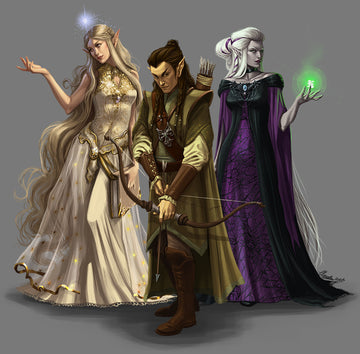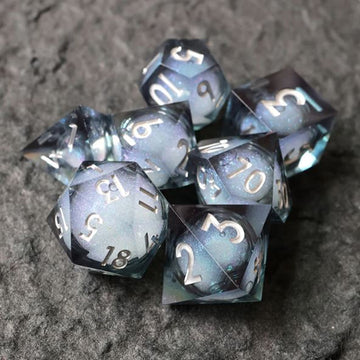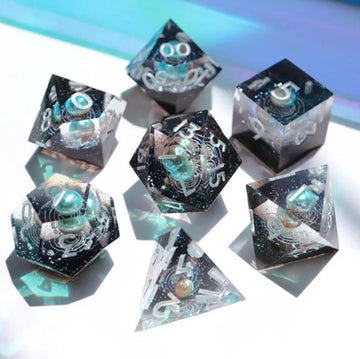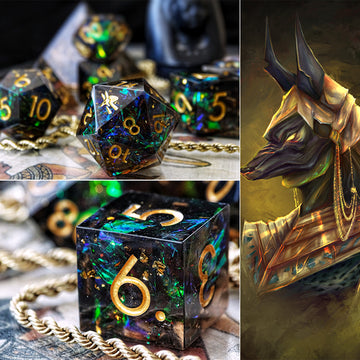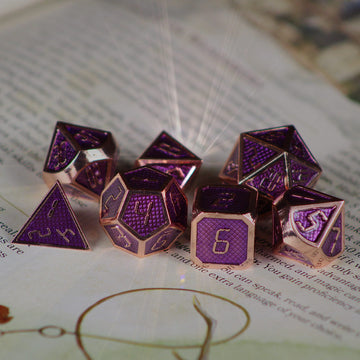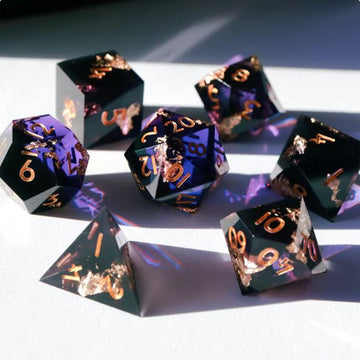Title image © Claudia Ianniciello
Mastering 5e Elves: Lore, Character Building, and Role-Play
Elves are one of the most popular races in Dungeons and Dragons fifth edition, and it's no surprise. Their representations across different media, with characters like Legolas, Zelda (lol jk "Link"), and Keyleth excite and inspire countless players.
This is not lost on Wizards of the Coast, which is why Dungeons and Dragons now has nearly a dozen 5e elf subraces.
And that is a LOT.
In this guide, we will explore everything you need to know about these magical people of otherworldly grace (sometimes...) before you choose what type of elf your D&D character should be. We'll talk about their lore, religion, mechanics, and each subrace in the Forgotten Realms.
Dungeons and Dragons Elf Lore
So, it turns out... in D&D there is more than one type of "high elf" and "wood elf"... because there are multiple official fantasy settings. The myths, histories, and personalities of official D&D elves depends upon which official fantasy setting you are playing in.
If you are playing a homebrew campaign, you should ask your Dungeon Master about their specific lore, but the 5e "default" would be the Forgotten Realms. Because of this, after the summaries below, we will stick to the lore and subraces in that campaign setting.
Forgotten Realms "Tel'Quessir" Lore
Throughout most of the long histories of the Forgotten Realms, elves reigned supreme as the prominent humanoid race. They were said to be born from Corellon's blood spilled by Gruumsh, the god of orcs, which partly explains why the orcs consider the elves to be their eternal foes. While some stayed in the Feywild (the Eladrin), most of the elves traveled to the material plane, building great cities and mastering magic and arts.
Their proclivity to distinguish themselves lead to their descent from glory. The first great tragedy for elves was the betrayal of the drow and their banishment to the Underdark. Later on, the remaining empires were nearly destroyed in the Crown Wars as they battled each other for supremacy. Among their remaining settlements and strongholds, the city of Silverymoon stands with silvery spires as a testament to the ancient elven power and resilience in the natural world.
Greyhawk "Olven" Lore
Greyhawk was the original D&D fantasy setting, so many of the Forgotten Realms histories also apply to Greyhawk. Their creation myth is the same, but while they lack unity, they also lack that inter-racial warfare. The dwelled along in the lands for hundreds of years before they encountered any of the other humanoid races. In Greyhawk, elves were originally in three groups: high elves of greyhawk, grey elves of greyhawk, and the valley elves of greyhawk. The setting was first developed in the '70s, and there are now FIVE AGES of detailed history, and it would take another 3k words to summarize. Instead, you can read it here.

© WOTC
Krynn "-esti" Lore
In the Dragonlance setting, elves were originally known by the first and greatest of them: the "silvanesti." These elves received glory for helping defeat evil dragons. They were noble, lovely, brilliant, and skilled. This, of course, went to their heads, resulting in their continued isolation and what would be the ruin of their strength... elven discrimination.
The silvanesti developed a caste system which, centuries down the road, lead to a schism led (and known by) the qualinesti. These elves prided themselves on social equity and cooperation with the other races of the world. This animosity would culminate in The Kingslayer Wars, where several silvanesti chose to fight their own kin for a human emperor.
There are three other types of Dragonlance elves scattered across Krynn: kagonesti of Dragonlance (wood elves), dargonesti of Dragonlance (sea elves), and dimernesti of Dragonlance (shaol elves).

© WOTC
Eberron "Strange Elves" Lore
The elves are notoriously "other" in the Eberron setting, considered as foreign, dangerous, and weird as orcs to humanoids. Their origin is also drastically different from the other settings: in Eberron, they were formerly a slave race to giants. Since earning their freedom, they have spread across Eberron and are divided into 4 cultures: Aerenal, Tairnadal, Khorvaire, and Drow. All of these elves guard and care for their own and are apathetic about everything else. That said, they fought for the right price in "The Last War."
The elves of Aerenal hold a profound reverence for death and engage in ancestor worship and have a longstanding enmity with the dragons of Argonnessen. The Khorvaire are splintered into dragonmarked houses, each granting them different magical abilities. The Tairnadal live as warrior tribes and are skilled on horseback. The Drow are still kind of evil, and are often underground, but worship a scorpion rather than a spider god, and are biiiiig into elemental magic.

© WOTC
The D&D 5e Elven Pantheon
The Seldarine, which translates to "the fellowship of brothers and sisters of the wood," is the elven pantheon of the Forgotten Realms. They dwell on Arvandor, which is technically the first, wooded layer of the plane Arborea. The evil deities that felt with Lolth are in her layer of the Abyss.
The Seldarine are led by Corellon Larethian; the eccentric, chaotic god of all things magical and artistic (which apparently includes war...?). Lolth was his wife, but she tried to kill him, betrayed him, lied to him, and was just the worst, so he banished her and her followers to the Abyss.
Other gods include:
- Aerdrie Faenya: Aarakocra and air elementals also sour with this ever-moving wind goddess.
- Sehanine Moonbow: A popular 5e deity that revels in secrets under the moon... and probably is Corellon's new consort (that's the reward for saving his life!)
- Labelas Enoreth: The book nerd who knows everything in the many, many histories of elves.
There are other gods within the Elven Pantheon, each who embody some version of nature, magic, and beauty. Different elven subraces may hold varying levels of reverence for certain deities within the pantheon. To learn aaaaaall about these many, many gods and goddesses, check out the Seldarine Forgotten Realms page.

© OneTrueBears
The 5e Elf Race: Mechanics and Stereotypes
All D&D 5e elves are inspired by classic fantasy, so we're talking "Tolkien" not "Santa's." Regardless of the subrace, 5e elves share the following appearance and traits:
Stupid Beautiful
5e elves are pretty to look at; even an ugly elf would be considered beautiful by human standards. They fit modern "supermodel" descriptions... slender frame, defined features, smooth skin... save for one exception: they are shorter than humans. The typical height of an elf is around 5-6 feet and they are no more than 150lbs soaking wet. As a result, they are more flexible than burly, and have a +2 to their Dexterity.
Play the Long Game
5e elves live hundreds of years, some over 700. But they also take about 100 years to reach adulthood. Their mental and physical growth is slow. In other words: the elven understanding of adulthood is: "there is no rush." They take the time (for them, that means decades and decades and decades) to master their craft. They look at events in their broader context and see small, petty things as transitory and threats as having many solutions.
In a Trance Under the Moon
5e elves delight to walk in twilit forests of a moonlit or starlit sky. They have darkvision, allowing them to see 60ft of dim light as though it were darkness and darkness as though it were dim. They also have to sleep at lot less... in fact, they do not get "hours of sleep" at all. They go into a 4 hour semi-conscious "Trance," allowing them to spend good portions of the night on the forest floor in meditation.
Connection to the Feywild
They were born of divine blood and grew up in the magic-steeped lands of the Feywild. Over time, they developed a natural resistance due to the constant enchantments and illusions. The effect of their Fey Ancestry means that they 1) have advantage on saving throws against being charmed and 2) they cannot be unwillingly put to sleep.
Magic, Arts, and Crafts
Another aspect of their Fey origins is their appreciation of beauty and mastery of talents. Every elven culture appreciates music, art, and high culture. They use their perception skill proficiency to discern quality and craftsmanship (among other things). This delight in the wonderful and beautiful translates into the magical. Whether it be arcane, natural, or clerical... each subrace of 5e elves has their own vein of magic they have mastered.
What Are the Best 5e Elf Classes?
Short answer: slender builds like rogues, rangers, and fighters.
Long answer: it's more complicated than that...
First thing's first: if you are using Tasha's Customizable Origin, then ANY class works great with 5e elves. Furthermore, the "best class" for YOUR elf depends on what subclass you choose.
That said, if you are going with the classic race block, all 5e elves gain a +2 to dexterity. While some classes use dexterity for attacks... all classes use it for initiative and stealth, and the DEX saving throw is the most important one in the game. In fact, just about every class except paladin and cleric thrive on high dexterity. But that's not very helpful... so instead of picking a "best class"... we are going to identify the best class for each subrace of elf.
Breaking Down the 5e Elf Subraces
In D&D 5e, elves range from joyful and bright to wicked and dark. They come in various subraces, each with unique abilities and traits. The right subrace will allow you to create the perfect thematic and mechanic fit between your character's personality and their class.

© WOTC
Who Are the Drow?
Let's start with the most controversial group: the DROW. First thing's first: drow society is matriarchal to the EXTREME, heavily influenced by the ruthless and irreducibly evil goddess Lolth. They are notorious for their hedonistic, cruel, domineering, and backstabbing nature. They have silvery hair and either pale, purple, or dark skin and are considered drop-dead gorgeous even by elven standards. They are the unquestionable superpower of the Underdark, existing in cities (ex. Menzoberranzan) and frequently raid the surface world for slaves. They are SO EVIL that many Dungeon Masters will forbid players from playing this kind of elf.
Best Class for Drow: Rogue
The rogue is all about striking precise attacks from the shadows... and all of the drow's abilities enhance that. Your Superior Darkvision lets you see enemies way before they see you and your Drow Magic (particularly Faerie Fire and Darkness) will make sure your enemies have a hard time hitting you while you slay them with ease. But while the drow LOOOOOOVE the dark, they love it perhaps too much. They have "Sunlight Sensitivity," which gives them disadvantage on perception checks when in direct sunlight, which might make adventuring... difficult.
Best Thematic Classes for Drow: Cleric
I have this in here because even though the drow have no mechanical bonuses that make them good clerics... thematically?... FEMALES are excellent, fascinating clerics. Once again, part of the evil goddess Lolth is that only women can serve her as clerics. Unlike your average nun, the drow women are also bigger and stronger than the drow men and regularly kill them for pleasure. How could you cooperate with your party as an evil drow cleric? No idea, but it would be very, VERY cool.

© Wizards of the Coast + R.A. Salvatore
"Who is the Famous D&D Dark Elf?"
There is only on answer: Drizzt Do'Urden. Shunning the horror of his people, he escaped his plight, survived the Underdark, and now adventures across the material plane with his companions, Bruenor Battlehammer, Drizzt Do'Urden and his companion Guenhwyvar, and Catti-brie, Wulfgar, and Regis.

© WOTC
Gettin' Haughty With "High Elves"
Ok, the literal moral opposite of the drow are the "high elves." Devoted to all things good, bright, and beautiful... so much so that there is a bit of a "savior complex." But can you blame them? They are the only 5e elves that live in cities in the material plane, each with marvelous architecture. They are known for BOTH their combat prowess and impressive intelligence.
Some confusion here... high elves are actually from the Greyhawk setting, and the term is nomenclature for a group of 5e elves called "sun," "moon," and "star."
- Star (Ruar-tel-quessir): Perhaps the most beautiful of all the elves, with pale skin and gold, red, or silver hair.
- Sun (Ar-tel-quessir): Sometimes called "gold elves," these elves are taller, heavier, and more accomplished (and arrogant) than all other elves, with black or copper skin and golden or blonde hair.
- Moon (Teu-tel-quessir): Extroverts that delight in interacting with non-elves. They have very light blue skin and raven black or snow white hair.
Best Mechanical Class for High Elves: Wizard
High elves are known to be a little smarter than other races (+1 to intelligence, and they know and additional language). They are also inherently magical (one extra cantrip). And they live for hundreds of years, giving them plenty of time to study. Put that together: they are the PERFECT wizards, whose spellcasting abilities requires high intelligence.
Best Thematic Class for High Elves: Any intelligence-based half caster.
A half caster is a class that has some spells, but can also fight. As stated above, the high elves make great wizards, but they also have proficiency in the longsword and long bow, which are solid martial weapons not available to most casters. While their +2 DEX may help a wizard dodge, it also helps a DEX-based martial warrior do everything else! In fact, I'm pretty sure the Bladesinger Wizard subclass was created exclusively for high elves!

© WOTC
Among the Trees with Wood Elves
Sometimes referred to as "forest elves" and "green elves," these 5e elves lived in... you guessed it... the woods and forests! These elves are deeply connected to nature, their keen senses heightened to perceive even the faintest rustle of foliage in their native forests, regardless of bright sunshine or heavy rain. After years of practice, each wood elf is a master hunter. Their connection extends to their appearance; they have light brown and tan skin with green and hazel eyes, black and brown hair.
While sharing their good nature, wood elves are noticeably different than high elves. In temperament, they are more mellow and eager to avoid direct conflict. Wood elves opt not to live in large communities, cities, or even towns; they choose to live in small villages that blend into the surroundings so well that adventurers are known to have wandered through a village without knowing it! This is in part to seeing, over the eons, the devastation wrought by ambitious nations. Instead of crafting towers, they craft bows, some of which are known as the greatest in Faerun.
Best Mechanical and Thematic Classes for Wood Elves: Ranger and Druid
Both classes require dexterity and wisdom as the top two ability scores... a wood elf has +2 to DEX and +1 to WIS. Both classes will require a player character to be at home in nature... A wood elf not only avoids civilization and lacks worldly experience, but also has "Mask of the Wild," enabling them to hide even when natural elements only lightly obscure them. Both classes tend toward long range attacks and staying out of melee range... the wood elf has 35 movement speed and is proficient in the shortbow and longbow, and don't forget about elven accuracy!

Art © Shkim, Character © FlyingSqrl
Shadar-Kai: Living in Extremes
D&D 5e completely re-wrote the lore on Shadar-kai, turning them from adrenaline-junky humanoids to unemotional elven edgelords. Here we will focus on the 5e version, but Dumpstat Adventures did a deep dive on the playable race (read it here)... I will let you be the judge on which is better.
Regardless of the edition, Shadar-Kai live in the dim conditions of the Shadowfell, a near-lifeless land ruled by the goddess of the dead: the Raven Queen. The Shadar-Kai are her reluctant, eternal servants. The Shadowfell and their service have taken effect on the Shadar-Kai's bodies; Shadar-Kai are the palest of pale, and many have hollow, deathly-looking faces so unseemly that many wear masks and shrouds.
Best Thematic and Mechanic Class for Shadar-Kai: Rogues
Shadar-Kai wear black, have tattoos and piercings, use serrated blades and barbed chains, and have darkvision for "night operations." On top of that, in general they look like a nasty biker gang... perfect for being a rogue stabbing from the shadows! The rogue is a DEX-based class and a +1 CON is perfect for this class. But above all, the Shadar-Kai's "Blessings of the Raven Queen" allows them to teleport 30ft once per long rest. This is ESSENTIAL for a rogue wanting to leap rooftops or dart between shadows separated by bright light.
What Does Darkvision Mean?
Darkvision is kind of a complex topic in D&D 5e. It gives player characters superrior vision in dark places, but it's not night vision goggles. Check out our post on darkvision to learn more:

© WOTC
Wild and Crazy Eladrin
Most of the 5e elves left the feywild... but not all. Those that remained in the realm of vibrant magic became the Eladrin, a race that resonates with the changing seasons... literally... both in physical appearance and emotional states. A single Eladrin can "change season,": and suddenly their personality is wildly different:
- Spring: Bright greens and pastels reflect their mischievous spirits and anticipation of a bright future.
- Summer: Vibrant greens and yellows mix with pure passion and rage.
- Fall: Browns and reds dominate their palate as they muse over what is and what can be.
- Winter: Every color from bright blue to deep purple matches the sorrow of a disappointed soul.
The signature class mechanic of the Eladrin is the Fey Step ability, which functions like an upgraded Misty Step, allowing an Eladrin to teleport 30ft into an unoccupied space. But at 3rd level, and upon succeeding a saving throw, the Eladrin can teleport a friend, deal damage, or frighten enemies (depending on the season).
Best Class for the Eladrin: Bard
With the +2 to charisma and the additional "spell" (Fey Step), the Eladrin work well with warlock and sorcerer... but neither are a perfect match. Eladrin are 5e elves with personalities turned up to 11. They are vibrant, emotional, loud, in your face; they are charismatic and go with their gut. Each one comes with different Personalities and Flaws options, implying hat the face is particularly designed with role-play in mind. All of these things are the EXACT same things that make a bard fun!

© WOTC
Astral Elves: Exploring the Multiverse
These 5e elves originated in... you guessed it... the feywild. But rather than staying put or heading to the material plane, these elves loved the night sky so much they took to the stars to draw closer to the gods.
This came with side effects: on the one hand, they have a slight "divine spark" in their eyes... on the other hand, they seem to be ageless. In fact, beings at home in the Astral Plane only age when they LEAVE the plane. The result is a peculiar attitude toward time and life itself. Events and empires are as fleeting as emotions, and all that is left is what inspires THEM... causing many to spend eons pursuing great quests or mundane passion projects.
Since this race has only existed post-Tasha's Customizable Origin, there really isn't a class that forms a perfect fit for astral elves. Yes, they have their special version of Misty Step (Starlight Step), but that works well with literally any class. The only nudge the subrace gives you is the "Astral Fire." This ability is inspired by that "divine spark" lore, and allows them to learn a cantrip from the cleric spell list.
Best Thematic Class Fit for Astral Elves: Monk, Way of the Astral Self
With eons to contemplate divine mysteries, it makes since that many of the astral elves' devotion would turn toward contemplation, a distinctly mystical/monk-ish activity. And just as astral elves see time as less than real, so do these types of monks see the body as an illusion, instead connecting with their astral body. Plus, the 5e elves' +2 DEX is exactly what a monk needs.

© WOTC
Sea Elves: A Deep Dive (lol get it?)
Sea elves are masters of the ocean depths, and they look it. Their skin is various shades of blue (water!) and their hair various shades of green (kelp!), though some appear to reflect the more colorful coral reefs they call home. But their bodies themselves are different from other 5e elves: they have longer limbs, thicker skin, and webbed hands and feet... kinda like the sea Na'vi.
All these distinct physical traits are there for a single reason: sea elves live underwater, mostly in the Sea of Fallen Stars. That is why they can breathe underwater, have a 30ft swim speed, and have resistance to cold damage. But their natural affinity for aquatic life doesn't end there; they can communicate with marine creatures, forging unique connections with the denizens of the sea.
Best Thematic Class for Sea Elves: Sorcerer
Like before, Tasha's Customizable Origin makes "great mechanic class fits" kind of pointless. However, thematically, there is nothing better than a sorcerer (particularly the Storm Sorcerer). Sorcerers are the most elemental of the spell casters, and of all the 5e elves, sea elves are the most in-tune with the pure elements.
Conclusion
In conclusion, mastering the art of building and role-playing 5e elf characters in D&D can be an exciting and rewarding experience. Whether you choose a wizard to harness the magical prowess of the 5e elves or a ranger to utilize their natural affinity for the wilderness, there are endless possibilities for creating unique and engaging 5e elves!
Pair Your Elf Character With Our 7-Dice Sets

The Elven Wizard Sharpedge Dice Set

Elven Green & White 7-Dice Set

Elven Translucent Blue 7-Dice Set
By Riley Rath - Freelance DnD Copywriter

